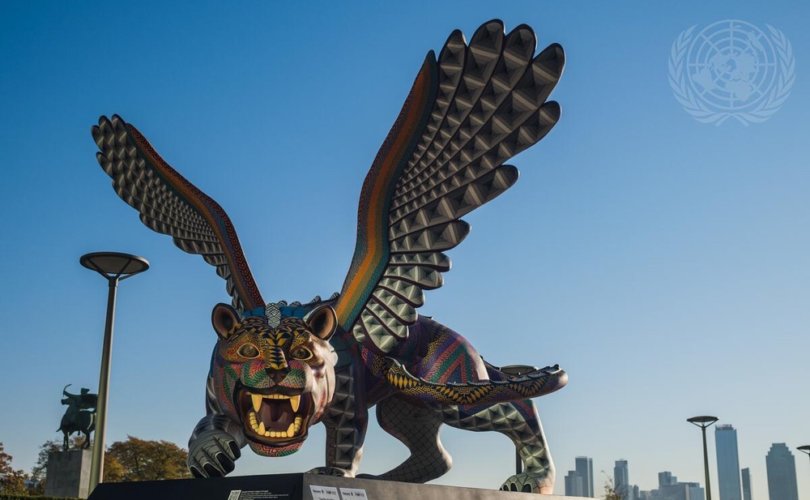NEW YORK (LifeSiteNews) – A statue outside the United Nations headquarters in New York City has drawn comparison to the “Beast of Revelation” described in the New Testament.
According to a United Nations Twitter account, the statue – “a fusion of jaguar and eagle” – is “a guardian for international peace and security.” It was donated by the Government of the Mexican state of Oaxaca, and was created by artists Jacobo and Maria Angeles.
A guardian for international peace and security sits on the Visitor’s Plaza outside #UN Headquarters. The guardian is a fusion of jaguar and eagle and donated by the Government of Oaxaca, Mexico @MexOnu. It is created by artists Jacobo and Maria Angeles.
UN Photo/Manuel Elías pic.twitter.com/q8SSsQhz1L— United Nations Photo (@UN_Photo) November 9, 2021
Commenters on social media have suggested that the statue resembles the “Beast of Revelation,” a creature described in the last book of the Bible.
Chapter 13 of the Book of Revelation says: “And the beast, which I saw, was like to a leopard, and his feet were as the feet of a bear, and his mouth as the mouth of a lion. And the dragon gave him his own strength, and great power.”
The Book of Revelation, also known as the Apocalypse, speaks about what will come to pass at the end of the world.
Artists have depicted the beast in different ways over time, often with wings like the U.N. statue.
The statue is done Alebrije-style, a type of art pioneered by Mexican artist Pedro Linares when he was 30 years old in 1936, allegedly after he suffered high fever and unconsciousness caused by peritonitis.
During his life, Linares described the hallucinations he experienced when he had fallen ill. He described seeing “a donkey with butterfly wings, a rooster with bull horns, and a lion with an eagle head.” The creatures were shouting, “Alebrijes! Alebrijes! Alebrijes!”
His work caught the attention of artists Diego Rivera and Frida Kahlo, who were part of Mexican Communist Party. Rivera was an avowed atheist who said, “I am an atheist and I consider religions to be a form of collective neurosis.”
Rivera and Kahlo were married but the latter had numerous extramarital affairs, with both men and women, and was known for dressing in male clothing.
While some view Alebrijes as a simple representation of Mexican folk-art tradition, others believe they transmit pagan and occult symbolism.
Before Mexico was a Catholic country, some of the pre-Christian societies in the nation practiced forms of paganism that involved significant human sacrifice. As Christianity has waned in public practice in Mexico, Alebrijes have become ubiquitous in popular culture, dominating the artistic landscape associated with the Día de los Muertos, a national festival that honors the dead.
Christians are divided on whether they should participate in the festival, with some focusing on traditional customs of praying for souls in purgatory during the month of November, while others worry that the holiday has been co-opted by the occult.
The 2017 Disney film Coco played on themes associated with the Día de los Muertos, and drew criticism for what critics believed were blurred lines between Christian and pagan/occult themes. The film used the Alebrije motif to depict creatures in the film. One of the creatures had a striking resemblance to the U.N. statue.


